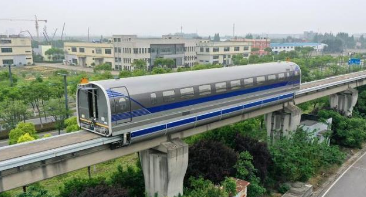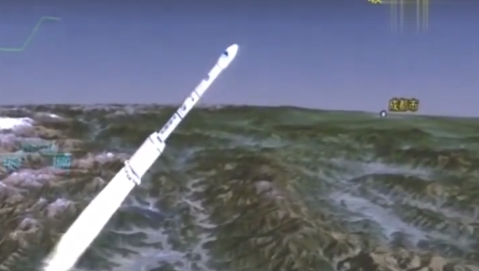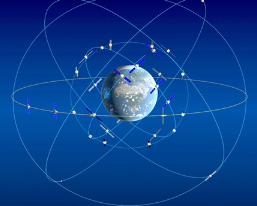New breakthrough: China's 600-km high-speed maglev test prototype successfully tested
my country's high-speed maglev research and development made important new breakthroughs The 600 km/h high-speed maglev test prototype developed by CRRC Sifang Co., Ltd. was successfully tested on the maglev test line of Shanghai Tongji University this morning. The development of a high-speed maglev transportation system at a speed of 600 kilometers per hour is a key special topic of the "Advanced Rail Transit" national key research and development plan of the Ministry of Science and Technology.

The project is organized by CRRC and CRRC Sifang Co., Ltd. is responsible for bringing together the domestic high-speed rail and maglev resources, and collaborating with more than 30 companies, universities, and research institutes to tackle the key issues of high-speed maglev core technology. The intellectual property rights high-speed maglev engineering system with a speed of 600 kilometers per hour has formed China's high-speed maglev industrialization capability. Since the project started in July 2016, after nearly four years of scientific and technological research, the project team broke through the key core technology of the high-speed maglev series and successfully developed a test sample vehicle. After ground debugging and static testing, the vehicle entered the line dynamic operation test. The first test run.
According to Ding Sansan, the person in charge of the subject of high-speed maglev and deputy chief engineer of CRRC Sifang Co., Ltd., high-speed maglev is a strong coupling system including four major systems including vehicles, traction power supply, operation control communication, and line and track. It can initially verify the interface relationship and coupling characteristics between high-speed maglev systems under dynamic conditions, providing support for the verification and optimization of key performance of the system and core components.
CRRC Sifang and Tongji University and other research units carried out the test. On the maglev test line, the test sample car was tested for the first time in joint system, and carried out dynamic operation tests under various working conditions, including different track beams and turnouts, small curves, ramps, zone switching, etc., and completed more than 200 seven major projects This project has conducted comprehensive tests on key performances such as suspension guidance, speed measurement positioning, vehicle-rail coupling, ground traction, and vehicle-ground communication.
"Under the conditions of multi-operating test conditions, the vehicle's suspension guidance is stable and the operating condition is good. The key technical indicators meet the design requirements and meet the design expectations." Ding Sansan said.
The successful trial run of the test prototype achieved a breakthrough from static to dynamic operation, and obtained a large amount of key data. The key performance of the high-speed maglev system and core components was initially verified, which provided for the development and optimization of the subsequent high-speed maglev engineering prototype. Important technical support.
According to reports, the research and development of the high-speed maglev project is progressing smoothly, and the development of five marshalling engineering prototypes is also steadily advancing. According to the plan, the prototype system of the high-speed maglev project with a speed of 600 kilometers per hour is expected to be rolled out by the end of 2020, and a full set of high-speed maglev technology and engineering capabilities will be formed. In the future, through the construction of a high-speed maglev demonstration project and related operations such as 600km/h line operation, this technology can promote the continuous innovation and industrialization of the technology, and promote the upgrading of my country's high-end equipment manufacturing and the development of strategic emerging industries.
As an emerging high-speed transportation mode, high-speed maglev has the advantages of high speed, fast, safe and reliable, strong transportation, comfortable and punctual, green and environmental protection, and low maintenance costs. It has a variety of application scenarios, and can be used for long-distance transportation, that is, "corridor" traffic, forming high-speed corridors between large hub cities or urban agglomerations, promoting inter-regional collaborative development; and suitable for short- and medium-distance passenger transportation, that is, "commuting" ", "Urbanization" transportation, used for commuting in big cities or intercity connection of neighboring cities in urban agglomerations, creating a half-hour to 1-hour economic circle, and promoting the development of "integration" and "co-urbanization" of metropolitan areas and urban agglomerations .
600 km/h high-speed maglev fills the speed gap between high-speed rail and air transportation, and can form a more reasonable, efficient, flexible and convenient multi-dimensional transportation structure for aviation, high-speed rail, high-speed maglev and urban traffic, to meet the needs of different people. In 2019, high-speed maglev was included in the national "Outline of the Construction of a Powerful Transportation Country" as a frontier key technology. The development of a high-speed maglev transportation system at a speed of 600 kilometers per hour will become an important supplement to China's high-speed transportation, help the implementation and promotion of the strategy of a powerful transportation country, and enrich China's modern comprehensive transportation system to achieve the continuous leading of China's rail transportation technology and seize international competition. The strategic commanding height has great and far-reaching significance.
 小任班长的博客
小任班长的博客 



